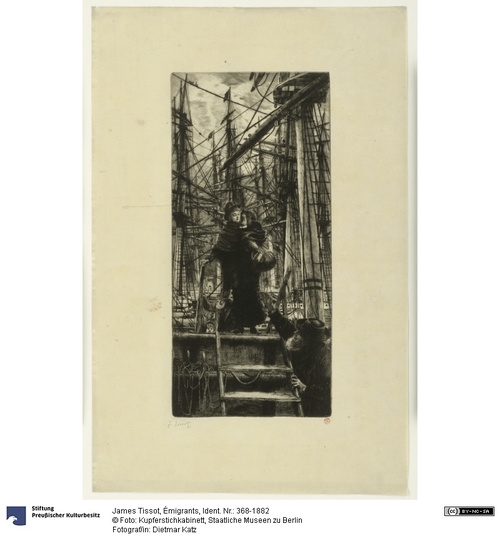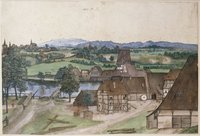Der Franzose James Tissot schuf ab 1860 zahlreiche druckgraphische Arbeiten, die wesentlich von Whistler und japanischen Drucken inspiriert waren. Fotografien und eigene Gemälde dienten als Vorlagen – auch das Blatt Emigranten entstand nach einem Ölgemälde aus den 1870er Jahren. Der Künstler selbst war in Folge seiner aktiven Beteiligung an der Pariser Kommune 1871 nach London geflohen, wo er diese Radierung anfertigte. In England konzentrierte sich Tissots Kunst auf mondäne Gesellschafts- und Damenportraits. Soziale Themen sind eine Seltenheit in seinem Œuvre, und auch in diesem Werk wird das brisante Thema der Flucht aus ökonomischen Gründen von der eleganten Erscheinung der Dame kontrastiert. Die wirtschaftliche Situation im viktorianischen England hatte viele Menschen zur Auswanderung, zur langen Reise nach Amerika und Australien gezwungen. Vor einem Gewirr aus Masten und Leinen steht eine junge Mutter in entschiedener und gleichermaßen fürsorglicher Haltung an der Anlegestelle. Dem Betrachter entgegen wird sie den ersten Schritt in eine neue Welt tun. Das subtile Rastergefüge, die Schwarzabstufungen, die Kombination von Klarheit und Chaos, der Einbezug der drei Lebensalter, kurzum ein zutiefst psychologischer Realismus zeugen von Tissots technischem Können und seiner Sensibilität für die Problematik von Ende, Flucht und Neuanfang.
Text: Ina Dinter, in: Wir suchen das Weite. Reisebilder von Albrecht Dürer bis Olafur Eliasson im Kupferstichkabinett, hg. von Hein-Th. Schulze Altcappenberg und Ina Dinter, Berlin 2016, S. 108
Beginning in 1860, French artist James Tissot created many prints that were inspired by Whistler and Japanese prints. He used photographs and his own paintings as models; also Emigrants was based on an oil painting from the 1870s. The artist himself after his active participation in the Paris Commune in 1871 fled to London, where he made this etching. After his arrival in England, Tissot’s art focused on sophisticated portraits of society and ladies. Social issues are rare in his oeuvre. In this work the explosive subject of flight for economic reasons contrasts against the elegant appearance of the lady. The economic situation in Victorian England forced many people to emigrate, to take the long journey to America or Australia. Against the backdrop of an entanglement of masts and ropes, a young mother stands in a decisive and yet caring pose at the dock, about to take a step to the new world, coming towards the beholder. The subtle patterns, the shades of black, the combination of clarity and chaos, the inclusion of the three ages of man, in brief a deeply psychological realism attest to Tissot’s technical finesse and his sensitivity for the problems of end, escape, and new beginnings.
Text: Ina Dinter, in: We’re off then. Travel Pictures from Albrecht Dürer to Olafur Eliasson in the Kupferstichkabinett, published by Hein-Th. Schulze Altcappenberg and Ina Dinter, Berlin 2016, p. 108
en

